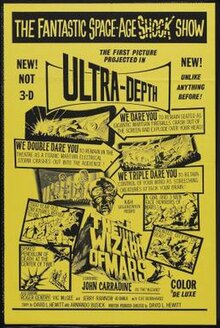
Mars, the fourth planet from the Sun, has appeared as a setting in works of fiction since at least the mid-1600s. Trends in the planet's portrayal have largely been influenced by advances in planetary science. It became the most popular celestial object in fiction in the late 1800s, when it became clear that there was no life on the Moon. The predominant genre depicting Mars at the time was utopian fiction. Around the same time, the mistaken belief that there are canals on Mars emerged and made its way into fiction, popularized by Percival Lowell's speculations of an ancient civilization having constructed them. The War of the Worlds, H. G. Wells's novel about an alien invasion of Earth by sinister Martians, was published in 1897 and went on to have a major influence on the science fiction genre.

The Martian Chronicles is a science fiction fix-up novel, published in 1950, by American writer Ray Bradbury that chronicles the exploration and settlement of Mars, the home of indigenous Martians, by Americans leaving a troubled Earth that is eventually devastated by nuclear war.
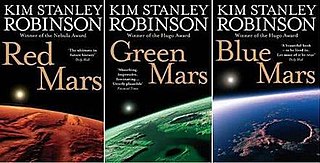
The Mars trilogy is a series of science fiction novels by Kim Stanley Robinson that chronicles the settlement and terraforming of the planet Mars through the personal and detailed viewpoints of a wide variety of characters spanning almost two centuries. Ultimately more utopian than dystopian, the story focuses on egalitarian, sociological, and scientific advances made on Mars, while Earth suffers from overpopulation and ecological disaster.

The Sirens of Titan is a comic science fiction novel by Kurt Vonnegut Jr., first published in 1959. His second novel, it involves issues of free will, omniscience, and the overall purpose of human history. Much of the story revolves around a Martian invasion of Earth.

Pavonis Mons is a large shield volcano located in the Tharsis region of the planet Mars. It is the middle member of a chain of three volcanic mountains that straddle the Martian equator between longitudes 235°E and 259°E. The volcano was discovered by the Mariner 9 spacecraft in 1971, and was originally called Middle Spot. Its name formally became Pavonis Mons in 1973. The equatorial location of its peak and its height make it the ideal terminus for a space elevator, and it has often been proposed as a space elevator location, especially in science fiction. It is also an ideal location for a Sky Ramp.
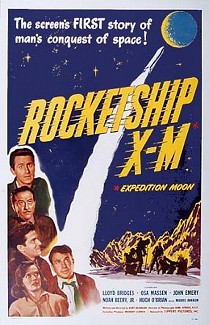
Rocketship X-M is a 1950 American black-and-white science fiction film from Lippert Pictures, the first outer space adventure of the post-World War II era. The film was produced and directed by Kurt Neumann and stars Lloyd Bridges, Osa Massen, John Emery, Noah Beery Jr., Hugh O'Brian, and Morris Ankrum.
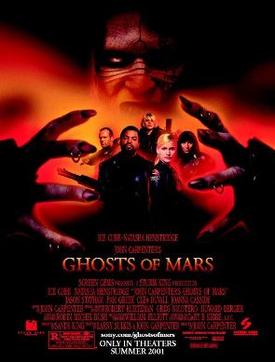
Ghosts of Mars is a 2001 American space Western action horror film written, directed and scored by John Carpenter. It was produced by Screen Gems and distributed by Sony Pictures Releasing. The film stars Natasha Henstridge, Ice Cube, Jason Statham, Pam Grier, Clea DuVall, and Joanna Cassidy. Set on a colonized Mars in the 22nd century, the film follows a squad of police officers and a convicted criminal who fight against the residents of a mining colony who have been possessed by the ghosts of the planet's original inhabitants.

A Princess of Mars is a science fantasy novel by American writer Edgar Rice Burroughs, the first of his Barsoom series. It was first serialized in the pulp magazine All-Story Magazine from February–July, 1912. Full of swordplay and daring feats, the novel is considered a classic example of 20th-century pulp fiction. It is also a seminal instance of the planetary romance, a subgenre of science fantasy that became highly popular in the decades following its publication. Its early chapters also contain elements of the Western. The story is set on Mars, imagined as a dying planet with a harsh desert environment. This vision of Mars was based on the work of the astronomer Percival Lowell, whose ideas were widely popularized in the late 19th and early 20th centuries.

Sphere is a 1998 American science fiction psychological thriller film directed and produced by Barry Levinson, adapted by Kurt Wimmer, and starring Dustin Hoffman, Sharon Stone and Samuel L. Jackson. It is based on Michael Crichton's novel of the same name. The film was released in the United States on February 13, 1998.

Firstborn is a 2007 science fiction novel by British writers Arthur C. Clarke and Stephen Baxter. It is the third book, billed as the conclusion of the A Time Odyssey series.

The Martian Chronicles is a 1980 television three-episode miniseries based on Ray Bradbury's 1950 book The Martian Chronicles and dealing with the exploration of Mars and the inhabitants there. The series starred Rock Hudson, Darren McGavin, Bernadette Peters, Roddy McDowall, Fritz Weaver, Barry Morse, and Maria Schell. It was aired on NBC in January 1980 in three episodes with a total running time of just over four hours. The series depicts Mars as having a "thin atmosphere" which humans can breathe, with water-filled canals and desert-like vegetation. The miniseries was directed by Michael Anderson and written by Richard Matheson.
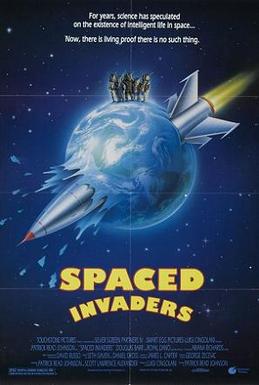
Spaced Invaders is a 1990 American science fiction comedy directed by Patrick Read Johnson and starring Douglas Barr, Royal Dano, and Ariana Richards.

RocketMan is a 1997 American comic science fiction film directed by Stuart Gillard and starring Harland Williams, Jessica Lundy, William Sadler, and Jeffrey DeMunn. A partial remake of the 1967 film, The Reluctant Astronaut, it was produced by Walt Disney Pictures and Caravan Pictures, and was released on October 10, 1997.

Flight to Mars is a 1951 American Cinecolor science fiction film drama, produced by Walter Mirisch for Monogram Pictures, directed by Lesley Selander, that stars Marguerite Chapman, Cameron Mitchell, and Arthur Franz.
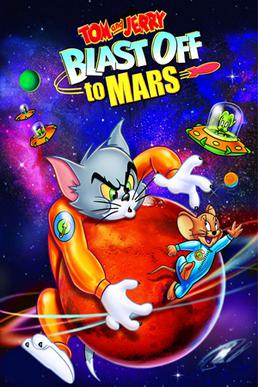
Tom and Jerry: Blast Off to Mars is a 2005 American animated science fiction comedy-adventure film starring the cat-and-mouse duo Tom and Jerry. Produced by Warner Bros. Animation and Turner Entertainment Co., it is the second made-for-video Tom and Jerry film.

The War of the Worlds is a 1953 American science fiction film directed by Byron Haskin, produced by George Pal, and starring Gene Barry and Ann Robinson. It is the first of several feature film adaptations of H. G. Wells' 1898 novel of the same name. The setting is changed from Victorian era England to 1953 Southern California.

Martian Land is a 2015 direct-to-video Science fiction action film directed by Scott Wheeler and starring Alan Pietruszewski, Lane Townsend and Jennifer Dorogi. It was made by The Asylum. In the tradition of The Asylum's catalog, Martian Land is a mockbuster of the film The Martian.
David L. Hewitt is a film director and producer. Among the films he has directed are The Wizard of Mars, Monsters Crash the Pajama Party, Journey to the Center of Time (1967), The Mighty Gorga (1969) and The Girls from Thunder Strip (1970).
The following outline is provided as an overview of and topical guide to Mars:

Mission Mars is a 1967 American science fiction film. It was produced by Everett Rosenthal, with a screenplay by Mike St. Clair from a story by Aubrey Wisberg, and directed by Nick Webster.
